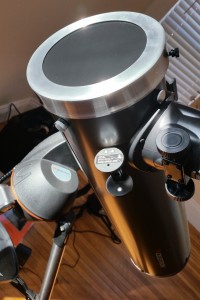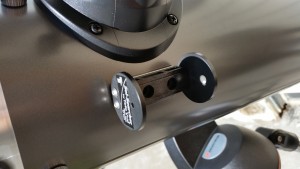Attleboro, Massachusetts, June 10, 2021, 5:30 a.m.-6:31 a.m. EDT
8×32 Lunt Sunoculars, 6×30 Lunt Sunoculars, welder’s glass, eclipse glasses



Attleboro, Massachusetts, June 10, 2021, 5:30 a.m.-6:31 a.m. EDT
8×32 Lunt Sunoculars, 6×30 Lunt Sunoculars, welder’s glass, eclipse glasses




Tokyo Astronomical Observatory Map of the Sun, March 21, 1959. Image: Kodaikanal Observatory Library / JR
I found a whole book of these maps of the Sun made for the International Geophysical Year (July 1, 2957 to December 31, 29158) in the library at Kodaikanal Observatory. It took me awhile to track down their origin, but I finally found the entire collection online at the Solar Science Observatory of the National Astronomical Observatory, Japan. (Scroll down to the section of the table that says “Map of the Sun in the IGY period),
According to the Historical Sunspot Drawing Resource Page:
According to the National Observatory of Astronomy Japan (NOAJ), the dome housing the 20-cm refractor built in 1921 by Mr. Chodayu Nishiura. The refractor, set on an equatorial mount with clock drive, was used to map sunspots from 1938 to 1999.
The day started out a bit cool, with me running around the house trying to find a good spot to set up. Started on the front sidewalk, but soon moved to the backyard. Spent most of the day observing, punctuated with frisbee breaks. I wish I had sketched more carefully to capture the effects of Earth-Sun rotation.

The solar filter covers the business end of the optical tube. Small bit of foam attached to the inside of the aluminum casing guarantee a snug fit. Photo: JR
DO NOT LOOK AT THE SUN WITHOUT PROPER EYE PROTECTION.
Before my last trip to India, I wasn’t much interested in solar observing. I enjoyed observing the Transit of Venus, considered getting a white-light solar filter my scope or investing in an h-alpha system, but never got around to doing either one. But being immersed in the history and ephemera of astrophysics and solar science at the Indian Institute of Astrophysics shifted something inside me. One of the first things I did after I returned to the U.S. was order an inexpensive filter for my small scope (130-mm reflector). I briefly considered ordering mylar sheets and building my own, but decided that I didn’t feel crafty enough to get the job done. I’m happy about that decision — the aluminum outer cell on my ready-made filter is much better (sturdier) than anything I could’ve put together myself.
It should go without saying, but never look through your telescope without a properly installed filter. The first thing I do when I go out, even before putting the optical tube on the tripod, is mount the solar filter. And I’ve made it a habit to double check the filter fit before I take my first look through an eyepiece in solar sessions.

Here, the optical tube and spotting tool are casting nice, circular shadows. This tells me that my scope is lined up well with the Sun. Photo: JR
I was pretty excited to get out there the day the filter arrived, but spent the first ten minutes in frustration. You’d think that it would be super easy to spot the Sun in a telescope. It’s a huge star, how hard could be it be? The answer to that question is: pretty hard. Don’t waste time chasing around the sky looking for the Sun. Look for its shadow instead. Use your controller or your hands to line your scope up with the Sun in such a way that it casts a perfect circle shadow. The sharper the circle, the closer the Sun will to the center of your field of view.
I eventually attached a spotting tool to my optical tube with velcro. It’s kind of handy, and helps me double-check my shadow circle. Now that it’s aligned properly (it came with alignment tools), I can just glance at it to check my alignment. Because looking at my shadow takes too much work, apparently.
The other thing that’s a must for starting your solar session is an eyepiece with a wide field of view and low magnification — the widest and lowest you’ve got. When you look at the sky through a solar filter, all you see is black. The Sun isn’t surrounded with a blazing light, so you can’t just scan until you see a glow (thus, initial alignment matters). It really helps to start with a wide field of view, just in case your alignment is a bit off. You can catch a corner of the Sun and move your scope gently to center it (and then adjust your spotting tool for next time).
I start out using a 32-mm plössl with a 52° apparent field of view (2.6° true field of view). This gives me a nice black field with a yellow orb near the center. Once I have the Sun completely centered, I work my way up through my eyepieces. I find with a 130-mm reflector, the best view of sunspots comes when I finally reach my 8-mm plössl (52° APOV, 1.2° TFOV). But I usually spend time with the 13-mm and 9-mm eyepieces as well.

The front panel of the Sol Search casts a shadow on the back. When my telescope is aligned with the Sun, the bright dot (the Sun shining through a hole in the front panel) is centered on the white circle on the back panel. Photo: JR
I can’t tell you what the best filter solution is for you, since it depends on what you want to see. My white-light system works well for me because I’m most interested in sunspots right now. But if you’re after limb activity and flares, you’re going to have to cough up some serious money for an h-alpha set up. At any rate, follow the manufacturer’s instructions for installing your filter/setting up your scope, lest you blind yourself. Don’t ever use a filter that goes on an eyepiece instead of the end of the optical tube. The tube filter prevents heat buildup — who knows what all that direct sunlight is doing to an eyepiece filter?
Even though most of the Sun is screened from your scope, setting up in full sunlight can lead to a miserable day. If you can find a partly shaded spot, you’ll thank yourself later. I also throw a dark shirt over my head to block the daylight from the eyepiece. Yeah, I look silly (I observe next to my house, which is next to a parking lot for a very busy convenience store, and you know everyone is talking about the idiot with a shirt over her head), but it really improves the view. Hooded observing shirts are available commercially, but they’re generally designed for cooler temperatures, not the bright of day.

Consider keeping an observing log. You can write down as much or as little detail as you want. I like to record my eyepieces and the number of sunspots I see. I find that just a few notes help me remember the session. Photo: JR
If you get serious about observing sunspots, consider joining the Astronomical League’s Sun Spotter’s Program. The AL is a beginner friendly organization, and with its guidance, you’ll soon be recording sunspots like a pro. If you’re more interested in prominences, flares, and other limb activity, check out the Astronomical League’s Hydrogen Alpha Solar Observing Program. Either way, feel free to contact me if you have any questions about getting started in solar observing.
The local astronomy club had telescopes set up at Lake Monroe for public use during the event, but I made my own viewer with a pair of binoculars, cereal box, piece of abandoned foam core, and temporary prop. I got some fantastic projected images despite the fact my sunshield said “Cheerios” on one side.